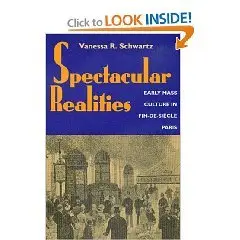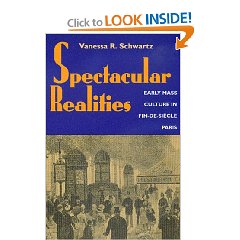Spectacular Realities: Early Mass Culture in Fin-de-Siècle Paris
By Vanessa R. Schwartz | Univ. of California Pr. | 1999 | ISBN 0520221680 | Pages 243 | PDF | 3.5 MB
During the second half of the nineteenth century, Paris emerged as the entertainment capital of the world. The sparkling redesigned city fostered a culture of energetic crowd-pleasing and multi-sensory amusements that would apprehend and represent real life as spectacle.
Vanessa R. Schwartz examines the explosive popularity of such phenomena as the boulevards, the mass press, public displays of corpses at the morgue, wax museums, panoramas, and early film. Drawing on a wide range of written and visual materials, including private and business archives, and working at the intersections of art history, literature, and cinema studies, Schwartz argues that "spectacular realities" are part of the foundation of modern mass society. She refutes the notion that modern life produced an unending parade of distractions leading to alienation, and instead suggests that crowds gathered not as dislocated spectators but as members of a new kind of crowd, one united in pleasure rather than protest.
Amazon review:
Reading Vanessa Schwartz's brilliant work Spectacular Realities: Early Mass Culture in Fin-de-Siècle Paris, one can get the feeling that the late nineteenth-century Parisian popular press was as omnipresent as the modern-day paparazzi. Throughout her enchanting narrative of the institutions and behaviors of an evolving mass culture, Schwartz characterizes the news consumption of a newly-literate population from the emerging print media as a key component to the identification of residents and visitors in fin de siècle Paris. The importance of print to Paris's cultural evolution does not preclude significant influences of visual media. In fact, Spectacular Realities argues that the creation and representation of Parisian society "relied on the explicit connection between written and visual texts." Schwartz's driving logic is that "a culture that became 'more literate' also became more visual as word and image generated the spectacular realities described" (3).
The book begins with a well-crafted introduction that locates the author's position contra the historical literature emphasizing written or visual texts as opposed cultural forms. Schwartz promptly introduces her post-modern view that "any history is a history of representation" (4) and she succinctly acquaints the reader with the work's star actors (the press, the boulevards, the morgue, the wax museum, panorama, and cinema). Schwartz, then, remains true to the proposed schema and devotes the subsequent 192 pages–with the focus of a steaming locomotive–to conveying perhaps the book's most salient point: "The visual representation of reality as spectacle in late nineteenth-century Paris created a common culture and a sense of shared experiences through which people might begin to imagine themselves as participating in a metropolitan culture because they had visual evidence that such a shared world, of which they were a part, existed" (6).
Similar to futurist Alvin Toffler's analysis of the fin de vingtiéme siècle in Powershift: Knowledge, Wealth, and Violence at the Edge of the 21st Century (New York: Bantam Books, 1990) that "knowledge is the most democratic source of power," the popular press of late nineteenth-century Paris empowered individuals to be or become Parisian by describing for them what "Parisian" was. The press, while creating a framework for viewing urban life, did not necessarily create that life. The city's Haussmannian boulevards established a new city center, complete with the displacement of workers and built-in social controls, where, according to a contemporary newspaper, "one can say everything, hear everything and imagine everything" (21). The boulevards provided a forum as an alternate venue for the revolutionary crowds, and the press created an imagined community of the street–a "boulevard culture"–in which the public could play a part.
Throughout the book there exists cooperation between reality and the representation of reality. The reinforcement of visual representation of reality as spectacle is most stark in Schwartz's discussion of the city morgue. Despite public participation in corpse identification as the municipality's basis for displaying dead bodies, "the morgue fit into a modern Parisian landscape in which the banal and the everyday developed in sensational narratives" (48). The popular press projected the morgue's display of death in Parisian society just as ravenously as it depicted la vie des boulevards. The entertaining spectacle of viewing the artful exhibition of nameless corpses, who played their part as would theatrical actors under stage direction, garnered little or no grief for the expired souls that had previously inhabited the bodies. As one of the most popular sites in Paris, with free admission and a visiting public of different classes and nationalities, the morgue provided a strikingly realistic dimension to add to the sensational narratives playing out on the streets of Paris and reported in her newspapers.
In a society that valued spectacle as reality, not even the established wax museums and the panoramas remained static. Arthur Meyer, director of Le Paris-Journal, placed the Musée Grévin in the liveliest part of the city and modeled the museum after the newspapers, offering the feuilleton, the échos, and the fait divers. In lieu of solely paying homage to past events, the museum communicated and illustrated current events to the public. By constantly changing displays to keep up with the changing events, the museum, similar to the boulevards, the press, and the department stores, attempted to define and project modern Parisian life.
The public continued to become more active in the spectacles of reality. The morgue allowed spectators to envision a corpse's manner of death. Panoramas relied on the audience-generated optical illusions. These illusions worked because they reflected the spectators' lionized views of modern life. As the public's threshold for realism increased, wax and panoramas gave way to mechanically simulated motion and cinematic productions. Instead of replacing these media, however, cinema continued with the technical capacity the trend toward realistic spectacle that had begun decades earlier. As Gabriel Thomas asserted at the time, "[The cinema] allows us to keep current events on our posters and thereby give complete satisfaction to the most demanding tastes of the public" (194).
Schwartz's analysis emphasizes the role of written and visual media in the shaping of Paris's mass culture. Yet, she does not relieve Parisians of agency. The public actively participated in the cultural flanerie, which Schwartz views as a kind of active spectatorship. It invited Parisians of all classes to assume a position within the spectacles, and therefore, secure a place within the imagined community. Schwartz describes this flanerie as empowering. The flaneurs "participated in [the spectacle] at the same time that they believed it was constructed for them" (131).
Spectacular Realities is written very much in line with Michael Miller's The Bon Marché (Princeton: Princeton University Press, 1981). Both works address Parisian bourgeois culture, during roughly the same period, as a culmination of, not a dramatic break from, cultural and social movements during the preceding decades of nineteenth-century Paris. Miller's Bon Marché projected and affirmed the identity of the bourgeoisie, while inviting others to aspire to become bourgeois. Likewise, in Schwartz's Paris, the spectacular realities defined and projected the communal identity of Parisians. The boulevards provided the setting, the popular press wrote the script, the morgue, wax museum, and panoramas exhibited the plot, and the mass public supplied the actors.
Schwartz contributes a vivid, forcibly-argued view of print media, visual images, and an empowered populace to our understanding of Paris's cultural history. This feat should not be overshadowed by the sometimes unclear influence of class status and gender roles within the late nineteenth-century Parisian mass community. The book, while acknowledging class and gender differences, seems to present the imagined community as an inclusive one. Notwithstanding Schwartz's well-researched, powerfully crafted account, one may wonder, however, if on some narrow, forgotten rue, there were not scores of individuals for whom the Parisian reality remained unspectacular.



